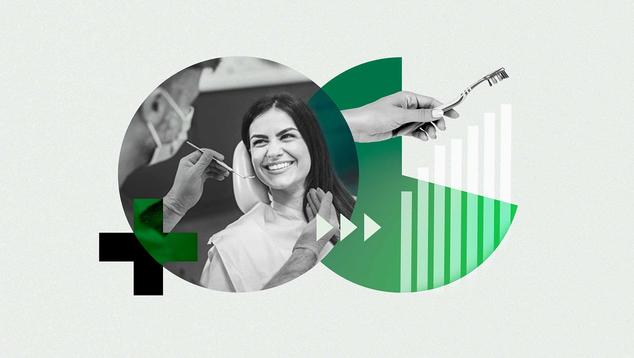Story Highlights
- Those who routinely visit a dentist rate their health and lives better
- Seven in 10 U.S. adults (71%) visit a dentist each year
- Lack of a personal doctor associated with not going to the dentist
WASHINGTON, D.C. — U.S. adults who have visited a dentist in the past 12 months are substantially more likely than those who have not to report better overall health. Four in 10 adults who have seen a dentist in the past year (42%) rate their health as “excellent” or “very good,” compared with 26% who have not been to a dentist, according to data from the Gallup National Health and Well-Being Index.
These findings are based on combined data from Quarter 4, 2024 (Nov. 26-Dec. 4, 2024) and Quarter 1, 2025 (Feb. 18-26, 2025), encompassing interviews with 11,906 U.S. adults surveyed by web using the probability-based Gallup Panel.
Oral health is often overlooked in conversations about overall wellbeing, yet its impact reaches far beyond the mouth. Poor oral health has been linked to a range of serious physical, mental and social outcomes, including:
- cardiovascular disease, through oral bacteria entering the bloodstream and contributing to arterial buildup
- respiratory infections such as COPD and pneumonia, caused by inhalation of oral bacteria
- various adverse pregnancy outcomes, when oral bacteria reach the placenta
- mental illnesses such as depression and anxiety, often linked to tooth loss, chronic bad breath and visible decay
Overall, 71% of U.S. adults report having visited a dentist in the past 12 months. Looking at key demographic subgroups, annual household income has, by far, the strongest correlation to doing so. Forty-six percent of adults living in households earning under $24,000 a year visit the dentist, compared with 86% of those in households earning $180,000 or more.
Routine Dental Care Associated With Higher Wellbeing Across Income Bands
While dental care and many aspects of wellbeing are closely tied to annual household income, their shared relationship to income alone does not account for the wellbeing advantage observed among those who visit the dentist. Across all income brackets — including lower-income (less than $48,000) and higher-income ($180,000 or more) — adults who have seen a dentist in the past year report higher levels of wellbeing than those who have not.
This pattern holds true for self-assessed overall health (noted above), as well as for measures such as feeling active and productive each day over the past week (a key indicator of daily energy and natural movement). The association between dental care and general life satisfaction, however, partially erodes among adults in households earning $120,000 or more annually. As such, the influence of income on life satisfaction appears to outweigh the role of dental care among higher earners.
Key Wellbeing Metrics Associated With Irregular Dental Visits
Much like regular dental visits are associated with a range of positive wellbeing outcomes, certain negative wellbeing indicators are strongly linked to not seeing a dentist. One of them is the absence of having a personal doctor, a factor that can signal a broader lack of access to primary care and trusted medical guidance. Seventy-six percent of adults with a personal doctor have visited a dentist in the past year, compared with 49% of those who do not have a personal doctor.
Financial strain also plays a significant role. Individuals without health insurance and those experiencing food insecurity — both indicators of poor financial wellbeing — are substantially less likely to have visited a dentist, consistent with broader patterns tied to income and dental visits. Smoking is another key correlation; the disparity in dental visits between smokers (51%) and nonsmokers (73%) highlights a pattern of behaviors tied to poor oral health outcomes.
Mental health challenges also appear to inhibit routine dental care. Those who report feeling significant loneliness the previous day are markedly more likely to have gone without a dental visit in the past year. In addition, the absence of having someone who encourages good health significantly reduces the probability of getting to the dentist each year.
Implications
The strong association between regular dental visits and many aspects of wellbeing highlights how oral care intersects with a life well-lived. Those who are mindful of good oral health are also more likely to report good overall health, to feel active and productive, and to rate their lives positively, thereby reducing the likelihood of downstream health issues in the process.
Many of these relationships are likely bidirectional. Experiencing significant loneliness, for example, may reduce the motivation to leave home or practice self-care, including dental hygiene. Conversely, poor oral health can contribute to psychological distress by affecting appearance, confidence and the ability to form social connections.
Regardless of the direction of causality, these data indicate that adults who maintain regular dental care tend to have higher overall wellbeing, positioning oral health as not only an important healthy behavior but also a meaningful contributor to a better life.
For community leaders, the reduced rate of routine dental care among those in lower-income households represents a potential opportunity to galvanize local dentists to step up discounted or pro bono services in underserved areas, thus serving a dual purpose of improving the oral health of constituents while also buttressing many other aspects of their wellbeing.
To stay up to date with the latest insights and updates, follow @Gallup on X and Instagram.
Learn more about how the Gallup National Health and Well-Being Index works.
Learn more about how the Gallup Panel works.




